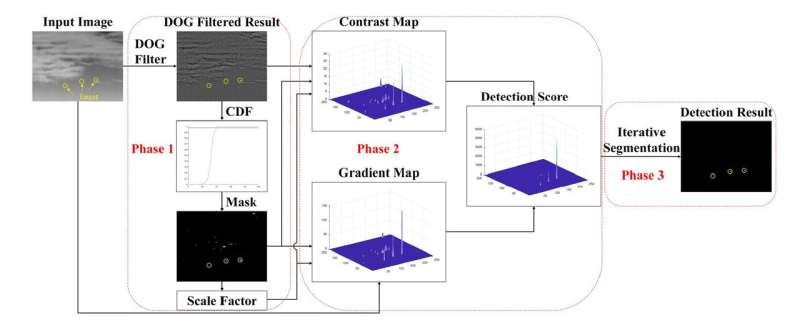Researchers find novel way to handle small infrared target detection

As the development of optic engineering, the infrared searching and tracking (IRST) system has been widely used. The operation distance of the IRST system is highly related to the detection performance of small targets, which are typically in complex backgrounds and with low signal-to-clutter ratio (SCR) and small size.
The small infrared (IR) targets exhibit popout behavior and the target textures and SCR are quite distinct from their surrounding pixels. The target pixels are different from the background pixels in terms of local contrast and gradient values. The combination of popout behavior and local SCR plays a key role in searching for target candidates efficiently, while the local contrast and gradient properties are effective for accurately distinguishing real targets from strong background clutters.
A research team led by Prof. Dong Yongsheng from the Xi'an Institute of Optics and Precision Mechanics (XIOPM) of the Chinese Academy of Sciences (CAS) proposed fast adaptive masking and scaling with iterative segmentation to perform the smarter and faster small infrared.
Considering striking the balance between speed and performance, the researchers applied a difference of Gaussian (DoG) filter to the input image and calculate a binarized mask, and adaptively estimated a scale factor based on the mask. The masks and scale factors enabled a fast and accurate overall target detection system.

They then combined the local contrast and gradient properties for high-performance target detection and background suppression. And the accurate extraction of the targets was performed by iterative segmentation. Results were published in IEEE Geosience And Remote Sensing Letters.
The detection scores/maps of the proposed the fast adaptive masking and scaling with iterative segmentation (FAMSIS) method and comparison methods are illustrated in Fig. 2., it should be noted that sequence one (S1) is a quite challenging data set because there are three targets in the last seven frames, two of which are quite dim and small.
The proposed method has a clear advantage in detecting challenging targets such as missiles in the second row. More importantly, the proposed method performed most robustly for the dim and small targets with strong clutter noise, as shown in the fourth and fifth row.
More information: Yaohong Chen et al. Small Infrared Target Detection Based on Fast Adaptive Masking and Scaling With Iterative Segmentation, IEEE Geoscience and Remote Sensing Letters (2021). DOI: 10.1109/LGRS.2020.3047524

















